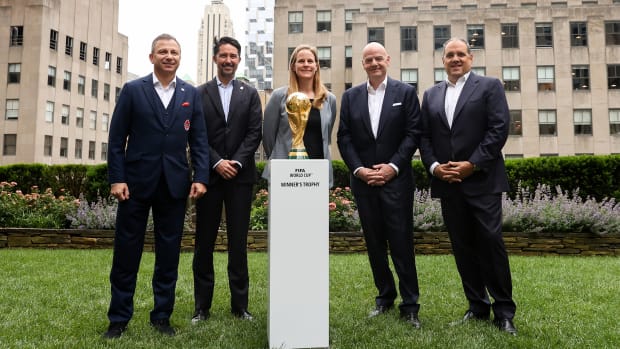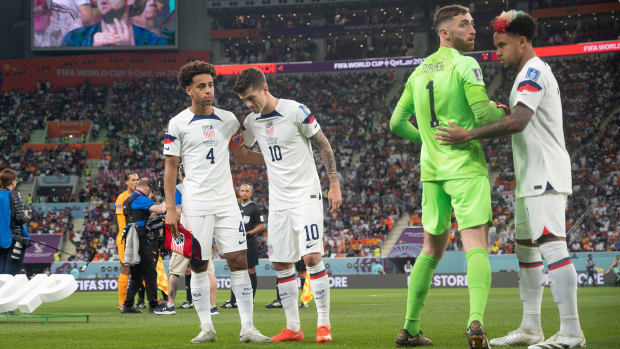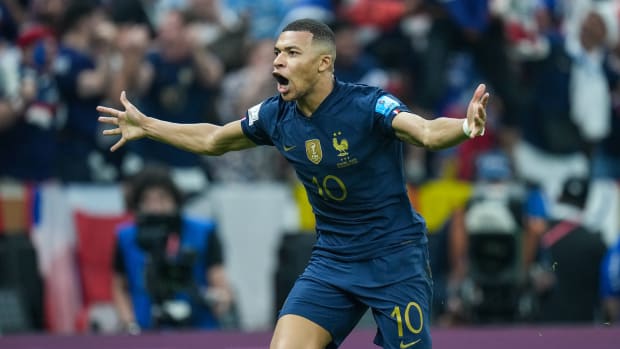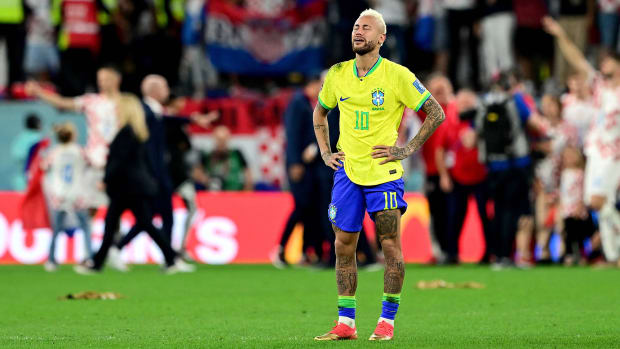The next men’s World Cup is going to look awfully different than its predecessor.
For starters, it’s going to take place across three North American countries, not one area with a smaller square mileage than Connecticut. It’ll have 48 teams, not 32. Infrastructure-wise, the stadiums are built with years to spare. A number of longtime stalwarts of the club and international game will likely be phased out by the time first kick takes place at city (or cities) TBD. You can expect that beer will be readily available.
In so many ways, the tournament that will take place in the United States, Mexico and Canada in fewer than four years will look nothing like what just transpired in Qatar. But what, really, might the 2026 World Cup look like? With a significant runway, here’s what we know, what we think we know and what’s still left to be determined in due time before the competition returns to North American soil:

Jessica Alcheh/USA TODAY Sports
THE HOST CITIES
FIFA unveiled its 16 host cities for 2026 in June, with the U.S. accounting for 11, Mexico three and Canada two. The games in the U.S. will be played in Atlanta, Boston, Dallas, Houston, Kansas City, Los Angeles, Miami, New York/New Jersey, Philadelphia, San Francisco Bay Area (Santa Clara) and Seattle. In Canada, they’ll be played in Toronto and Vancouver, while in Mexico, they’ll be in Mexico City, Guadalajara and Monterrey.
Each nation is slated to get an opener, while the U.S. will host everything from the quarterfinals on—at least as long as any alterations to FIFA’s initial plan and format (more on that below) don’t change that.
USMNT’S OUTLOOK
Projecting any squad four years out is a bit of a fool’s errand (not that that has stopped us before), but the vast majority of the 2022 team—and those who missed out on a trip to Qatar due to injury—should still factor in heavily in four years.
Consider that Sergiño Dest, Gio Reyna, Yunus Musah and Brenden Aaronson will all still be 25 or younger. Tim Weah will be 26. Christian Pulisic and Tyler Adams will be 27. Weston McKennie and Antonee Robinson will be 28. The glaring questions entering this last World Cup—striker and center back—remain the chief ones going forward, though there’s at least ample time to figure out the answers.
Who will be managing the U.S. is a bigger question. Gregg Berhalter’s contract is up, and the decision regarding his future and that of the position will dictate plenty going forward. The same goes for who manages the U.S. U-23s in the 2024 Olympics—if it’s different than the senior national team manager. Another big question is whether the U.S. can carve out a place in the 2024 Copa América, as has reportedly been discussed. Given the lack of meaningful matches and competitions over the next three-and-a-half years due to the U.S.’s anticipated automatic qualification, anything that can provide a step up from friendlies, Gold Cup and Nations League fixtures will go a long way toward further preparing a team that held its own against some of the world’s best in Qatar but saw just how far it has to go to truly compete at this level.
“We wanted more obviously from the tournament,” Adams, the U.S. World Cup captain, told Sky Sports on Tuesday. “What we’ve had to come to terms with is that only one team leaves the tournament happy. You need to compete at the highest level in every game and when you let your foot off the gas for one second, then teams will punish you. So we went toe to toe with some of the best teams in the world and now you have to put your sights toward 2026 when the World Cup comes back to the U.S.”

Stephen Nadler/ISI Photos/ZUMA Wire
WHAT ABOUT THE CO-HOSTS?
Canada and Mexico will enter 2026 after varying experiences in Qatar. Canada’s men, back in a World Cup for the first time since 1986, had a rude awakening after making a notable first impression. It outplayed Belgium, only to lose, and, after falling to Croatia and Morocco (which went on to finish third and fourth overall, respectively), it still does not have a point in six all-time World Cup matches. But some necessary lessons were learned—maybe lighting a fire under Croatia with ill-advised bulletin board material wasn’t so wise—and valuable experience was gained. Canada’s core, like the U.S., is young. Alphonso Davies will be 25, Jonathan David will be 26 and Tajon Buchanan will be 27 in 2026. There’s promise to build off.
Mexico’s in a bit of a different boat. Outgoing manager Tata Martino didn’t expose any of El Tri’s up-and-coming players to the World Cup, either by leaving them off the roster entirely (Santi Giménez and Diego Lainez, for example) or not trusting the ones who were brought along to perform. Mexico wound up being eliminated in the group stage, snapping its streak of seven straight last-16 ousters. With a new manager coming in and aging veterans on their way out, there’s a rapid rebuild that needs to happen for Mexico to enjoy the same success it did in its previous two times as host (quarterfinal finishes both times).
THE FAVORITES
Again, a lot can change in four years. Argentina has proven to boast a strong core outside of Lionel Messi, but if he’s really done on the World Cup stage (and who could blame him after that crowning achievement), it’ll be beyond a challenge to replace his aura and seismic impact to the point of pulling off a repeat.
Otherwise, expect more of the usual suspects. Brazil and France should factor in heavily, with both boasting a bevy of stars at the right age and period of their careers, though both will also likely have to replace some stalwart veterans who played key roles in their 2022 runs. Euro 2024 should tell us plenty about which European nations have progressed and dictate whether England and Spain’s young talent has coalesced, whether Germany has gotten over its scars of the last two World Cups and whether Portugal has fully moved on from Cristiano Ronaldo, among other developments.

Ayman Aref/NurPhoto/Imago Images
THE STARS
Kylian Mbappé, who turned 24 Tuesday, did little to dispel the notion that his time has arrived with his Golden Boot–winning showing in Qatar (and heroic hat trick in the final). The only question come 2026 is what club he’s playing for and what any potential club drama that has transpired has done to his trajectory. His PSG contract runs through ’25. Meanwhile, Enzo Fernández, 21, and Julián Álvarez, 22, played significant roles in guiding Argentina to the title. Jude Bellingham, 19, and Bukayo Saka, 21, did plenty of the same for England in their introduction to the global stage. They’ll be some of the chief performers realistically hitting their primes in the summer of 2026.
Others include Germany’s Jamal Musiala, 19, who showed his quality throughout the group stage, while Dutch forward Cody Gakpo, 23, made a greater name for himself as well. Spain needs to look no further than its 20-and-under Barcelona trio of Pedri, Gavi and Ansu Fati, which leads its generation of the present and future. Meanwhile, Brazil can build around Real Madrid’s Vinícius Júnior, 22, and Rodrygo, 21, knowing that its attack is in good hands. Defensively, Croatia’s Joško Gvardiol, 20, was immense in Qatar (save for being on the wrong end of a Messi highlight, but that’s more a right of passage than a strike against his quality), as was Serbia’s Strahinja Pavlović, 21, before his side’s group-stage elimination. They should only grow in stature to join the more established ranks such as Morocco’s Achraf Hakimi, who will be 27 and could easily be the preeminent fullback in the world (if he isn’t already).
A big wild card here, too, is expansion. Which national teams that may not have otherwise qualified for a 32-team event will get a chance to shine? Maybe Norway, so Erling Haaland and Martin Ødegaard can compete on the World Cup stage? Might Egypt, so Mohamed Salah can get another chance even at 34? One would also expect those who surprisingly missed out in 2022, like Italy, to have little problem qualifying.
As for those occupying the current top tier of global stardom, Messi said 2022 was his last World Cup, though he also vowed to continue representing Argentina so he can wear the national team shirt as a world champion. Ronaldo will be 41 in 2026 and already has begun to be phased out by Portugal. Luka Modrić will be 40. Playing at Euro 2024 could be feasible, but beyond that, another World Cup seems unlikely. Reigning Ballon d’Or winner Karim Benzema, who missed the World Cup for France through injury, just retired internationally this week at 35. Robert Lewandowski will be on the verge of turning 38, which doesn’t rule a player of his physique out entirely, but it does call his future into question.
There’s a slightly younger tier that includes the likes of Kevin De Bruyne (currently 31), Son Heung-min (30), Sadio Mané (30) and Harry Kane (29), who still figure to be performing at a high level but could be on the downswing of their careers (although, as Benzema and Lewandowski have shown as they have aged, perhaps not).
The biggest question mark of them all may be Neymar. He had already hinted that Qatar could be his last World Cup, and that was before a devastating quarterfinal defeat to Croatia that left him in tears and discussing how hard it will be to overcome. He’ll be 34 at the time of the 2026 World Cup, and perhaps the rush of bringing to his nation what Messi just did for Argentina will be motivation enough to keep going. Brazil, after all, did hoist the World Cup the last time the men’s final was played on U.S. soil.

Michael Kienzler/Ulmer/Teamfoto/Imago Images
WHAT WE STILL DON’T KNOW
- The format and structure
We know FIFA is expanding to 48 teams, but the initial plan of 16 three-team groups appears to be up in the air. The intense drama brought about by the simultaneous group finales in Qatar should be reminder enough to FIFA that doing away with that aspect of the competition should be strongly reconsidered. Some of the indelible images and moments from this past World Cup came in those finales, not the least of which was South Korea stunning Portugal in stoppage time, then gathering together to watch the end of Ghana-Uruguay, as a helpless Luis Suárez sobbed on the bench. The Koreans’ celebration with their fans, in one stadium, while the events happening at another dictated their fate was theater at its finest.
Going to 12 groups of four adds more games to an already packed calendar, however, so it remains to be seen what FIFA will do to structure this competition.
- The knockout and final sites
We know the U.S. is hosting every game from the quarterfinals on, and the likely sites for the semifinals and the final have been touted aplenty. The gargantuan NFL stadiums in Los Angeles, New York/New Jersey and Dallas seem to be the leaders for the marquee matches.
- Qualification formats
Each confederation will sort its qualification process to account for the growth in places (Asia already has, for instance). With Concacaf’s top three teams already in, it remains to be seen what the host region will do to put forth its remaining entrants (three more automatic qualifiers and intercontinental playoffs).







